Wednesday, January 31, 2007
"Hearty Fellows", in Winter's "Grip" in "Gillam"!
Manitoba is "chock-full" of hearty souls in winter-time. From the trappers on ski-doos with freezer-burnt faces, to the Lake Winnipeg fishermen, pulling nets through the ice with "wet" mitts, to the heavy equipment operators building roads across frozen lakes, with every foot forward, risking an "icy plummet" to the bottom. These are just some of the "hearty souls" involved in a Manitoba winter. Obviously, the economy and commerce don't stop in winter, so businesses consider the winter months "business as usual". Mining and exploration also continue, and aircraft are the "vehicle of choice" to transport and supply crews during the winter. "Spanky" and Dave from Blue Water Aviation Services recently made the "northbound trek" to Gillam, "end of the road" Manitoba, along with "stalwart Otter" C-GBTU, to fly crews and supplies to some "bush camps". Check out the pics "Spanky" sent me on his return, and tell me if "mining crews" and "bush pilots" fit the "hearty soul" profile. One extra "snippet" of information. Daytime temperature "highs" were -30*C while the boys were up at Gillam.
 "Enroute"!
"Enroute"!
 Gillam, Manitoba, with Pat Chartier's "Islander" and "Aztec" in the background, wearing "parkas".
Gillam, Manitoba, with Pat Chartier's "Islander" and "Aztec" in the background, wearing "parkas".
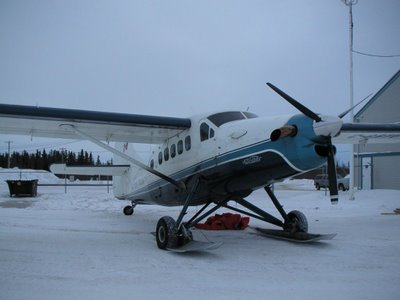 BTU "loaded", preparing to head for the "bush"!
BTU "loaded", preparing to head for the "bush"!
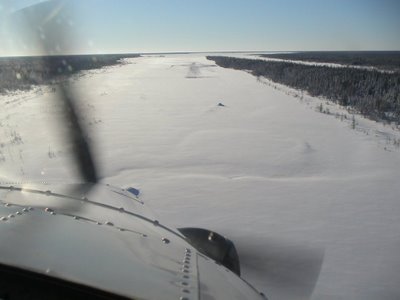 "On final" for the "bush strip"!
"On final" for the "bush strip"!
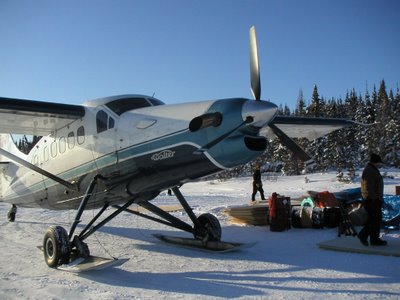 1957 Otter C-GBTU, S/N 209!
1957 Otter C-GBTU, S/N 209!
 Unloaded! Notice the "swimwear" everyone is wearing!
Unloaded! Notice the "swimwear" everyone is wearing!
 A typical "cornucopia" of supplies hauled into a "bush camp". Hey, what is all that lumber and plywood for?
A typical "cornucopia" of supplies hauled into a "bush camp". Hey, what is all that lumber and plywood for?
 For the hotel rooms, you dummy! "Cozy" accommodations!
For the hotel rooms, you dummy! "Cozy" accommodations!
 An Otter "in the bush", ingrained in "Canadiana"! So, what are your thoughts? Do exploration crews and "bush pilots" fit the "hearty fellows" profile? I would be "inclined" to think so! And the last word of my "Post" goes to Spanky, as he enjoys the "heat" from the "blazing sun", from the "balmy, heat-scorched" netherlands of northern Manitoba!
An Otter "in the bush", ingrained in "Canadiana"! So, what are your thoughts? Do exploration crews and "bush pilots" fit the "hearty fellows" profile? I would be "inclined" to think so! And the last word of my "Post" goes to Spanky, as he enjoys the "heat" from the "blazing sun", from the "balmy, heat-scorched" netherlands of northern Manitoba!

 "Adios"!
"Adios"!
WEBSITE - Blue Water Aviation Services Ltd.
 "Enroute"!
"Enroute"! Gillam, Manitoba, with Pat Chartier's "Islander" and "Aztec" in the background, wearing "parkas".
Gillam, Manitoba, with Pat Chartier's "Islander" and "Aztec" in the background, wearing "parkas". BTU "loaded", preparing to head for the "bush"!
BTU "loaded", preparing to head for the "bush"! "On final" for the "bush strip"!
"On final" for the "bush strip"! 1957 Otter C-GBTU, S/N 209!
1957 Otter C-GBTU, S/N 209!  Unloaded! Notice the "swimwear" everyone is wearing!
Unloaded! Notice the "swimwear" everyone is wearing! A typical "cornucopia" of supplies hauled into a "bush camp". Hey, what is all that lumber and plywood for?
A typical "cornucopia" of supplies hauled into a "bush camp". Hey, what is all that lumber and plywood for? For the hotel rooms, you dummy! "Cozy" accommodations!
For the hotel rooms, you dummy! "Cozy" accommodations! An Otter "in the bush", ingrained in "Canadiana"! So, what are your thoughts? Do exploration crews and "bush pilots" fit the "hearty fellows" profile? I would be "inclined" to think so! And the last word of my "Post" goes to Spanky, as he enjoys the "heat" from the "blazing sun", from the "balmy, heat-scorched" netherlands of northern Manitoba!
An Otter "in the bush", ingrained in "Canadiana"! So, what are your thoughts? Do exploration crews and "bush pilots" fit the "hearty fellows" profile? I would be "inclined" to think so! And the last word of my "Post" goes to Spanky, as he enjoys the "heat" from the "blazing sun", from the "balmy, heat-scorched" netherlands of northern Manitoba!
 "Adios"!
"Adios"!WEBSITE - Blue Water Aviation Services Ltd.
Monday, January 29, 2007
Steve's Video Of The Day: Durability Definition: "F-15 Eagle"!
Saturday, January 27, 2007
Steve's "Otter Of The Week"!......by Karl E. Hayes
I was thinking about Otters I "have known" the other day, and for some reason one particular Otter came to mind. I had never flown her, but she was a "regular" in Manitoba, flying for Knee Lake Lodge during the 1990s. During the winter she was stored at Selkirk Air's Base, and she sat on her floats, her ungodly "pinks and purples" getting double-takes from all the people who came to "gawk" at the airplanes. Knee Lake sold this particular Otter, and purchased an "amphibious Caravan". Then, she was gone from our area, and I never heard from her again...... I always wondered where she went. Let's find out, with the information coming from Karl Hayes' "masterful" CD entitled:
De Havilland Canada
DHC-3 OTTER
A HISTORY
First, some more acknowledgements from Karl.
-------------------------------------------------------------------------------
Acknowledgements
This work would not have been possible but for the high level of co-operation received from many military units, government departments, operators and enthusiasts throughout the world and I would personally like to express my appreciation to all who have helped.
GOVERNMENT
British Antarctic Survey
Captain G.Studd, Chief pilot; Bernard Moran and Fani Karagianni.
Canada
J.E.Lafontaine, Superintendent, Aircraft Licensing and Register; Miss J.F.Pedley, Aviation Safety and Investigation; the staff of Transport Canada, Civil Aviation Section, Ottawa; National Archives, Ottawa; National Library, Ottawa; Transportation Safety Board of Canada.
Civil Air Patrol
Frank O.Lowry, Chief, Office of Public Affairs; Colonel Marc Stella, Alaska Wing.
Costa Rica
Ministerio de Obras Publicas Y Transportes, San Jose.
Province of Manitoba
A.N.Dancyt, Superintendent of Maintenance, Department of Highways & Transportation;
Steve Doolan, Chief Pilot.
Province of Ontario
W.K.Warner, Chief Pilot; George Willoughby and Robert S.Grant.
Province of Quebec
Gilles Simard, Director of Operations
RCMP
N.Brisbin, Director, Air Services
Saudi Arabia
Boyd Shaw, Aviation Adviser, Ministry of Petroleum & Mineral Resources, Jeddah.
United Nations
Ola Husa, Director, Office of General Services, New York; E.Sochor, Public Information Office and Emily Zay, Information Assistant, ICAO.
United States
The staff of the Federal Aviation Administration (FAA), Oklahoma and the National Transportation Safety Board (NTSB).
Otter 197
Otter 197 was delivered to Perini McNamara Quemont, a construction company based in Montreal on 8th January 1957 with 'fixed' registration CF-PMQ. The three constituents of the firm were Perini Inc, McNamara (Quebec) Inc and Quemont Construction Inc, all of Montreal. The companies used the Otter, which was on amphibious floats, to fly construction crews to locations in the bush. The Otter, still on amphibious floats, was sold to Timmins Aviation, who subsequently sold it on for $90,000 to Eastern Provincial Airways Ltd (EPA) Gander and it was registered to them on 15th January 1959, being re-registered to Eastern Provincial Airway (1963) Ltd when the company was re-structured, following its merger with Maritime Central Airways in September 1963. Although based at Gander, the EPA Otters performed much of their flying in Labrador, based out of Goose Bay.
In 1970 Eastern Provincial Airways divested themselves of their bush operation, which was sold to senior company employees in a management buy-out, and re-named Labrador Airways, and based at Goose Bay, Labrador. PMQ was part of the deal, along with the company's other Otters, and was registered to Labrador Airways on 14th January 1971. It flew on the scheduled services of Labrador Airways from Goose Bay to the coastal communities of Labrador, and also on charter work. One incident was recorded, at Forteau Pond, Newfoundland on 26th February 1974. As the accident report states: “Overload failure; selected unsuitable terrain; rough/uneven terrain; collided with snowbank; substantial damage”. The Otter was repaired and continued in service with Labrador Airways until sold to Rog-Air Ltd of Port Loring, Ontario, to whom it was registered as C-FPMQ on 17th September 1981. After a few years flying for Rog-Air, it was sold to Lindbergh's Hunting & Fishing Air Service Ltd of Cochrane-Lillabelle Lake, Ontario, to whom it was registered on 21st January 1986.
C-FPMQ met with an accident at Sangster Lake, Ontario on 23rd August 1986. The Otter had departed from its base at 1905 hours to transport two passengers to a camp 65 miles to the northeast and return with four passengers from the same camp. While en route to the camp, the pilot was in radio communication with another pilot, who advised him of shallow water and rocks at the camp dock. Upon arriving at the camp, the pilot landed and taxied to a bay near the dock. The two passengers on board and their equipment were taken ashore and four passengers with their equipment were brought out from shore by boat. Several trips between the aircraft and the dock were required to transport the equipment. It was accordingly after sunset before the aircraft was ready for departure. While en route, twenty miles short of his destination and in the vicinity of Sangster Lake, the pilot observed lights on the shore of the lake and decided to land and remain overnight. During the landing, the pilot mis-judged the aircraft's height above the water and the aircraft struck the water in a nose-down attitude, causing the floats to separate from the aircraft which then sank. The occupants all evacuated the Otter and were rescued from the water by campers, who came out from the shore by boat.
The wrecked Otter was fished out of the lake and trucked to Kuby's Aircraft at Kenora, Ontario where over the following years it underwent a slow rebuild. When this was complete, the Otter was sold to Knee Lake Air Service Ltd of Knee Lake, Manitoba to whom it was registered on 29th July 1994. After five years operation with this company, the Otter was sold to R&J Aircraft Leasing Corporation of Anchorage, Alaska to whom it was registered N197TT on 14th July 1999. For a time the Otter was leased to Talon Air Service Inc who flew it from their base at West Mackey Lake, Soldotna, Alaska. The following year, the Otter was joined by two more, N362TT, also registered to R&J Aircraft Leasing Corp and N361TT, registered to Kakeldey Leasing Corp, an associated company. The three Otters were based at Anchorage, but leased out during the summer months to outfitters, hunting and fishing companies who use the Otters to fly their customers throughout Alaska. Up to June 2004, N197TT was flying for Alaska Air Taxi, based at Anchorage, on lease from R&J Aircraft Leasing.
In August '04 the Otter was chartered by Mavrik Aire of Kenai, Alaska, an outfitting company which flies its own Otter, a Walter Turbine conversion N103SY (296) as well as a Beaver and some single Cessnas. During the fall hunting season, Mavrik Aire operates out of Kotzebue and needed some extra capacity, so it chartered N197TT which was flown on the charter by Ronald Kakeldey, the owner of R&J Aircraft Leasing Corp and of Kakeldey Leasing Corp. Sadly, in the course of this charter, the Otter crashed on 27th August 2004 and was destroyed.
To summarise the NTSB accident report: “On Friday, 27th August 2004 about 1630 hours Alaska daylight time, a tundra tire equipped DHC-3 airplane N197TT was destroyed by impact and post-impact fire when it collided with trees and mountainous terrain about 35 miles west of McGrath, Alaska. The airplane was on a VFR cross country flight when the accident occurred. No flight plan was filed nor was one required. The Otter was one of a flight of two airplanes, transporting hunting camp supplies from Kenai to Kotzebue. The airline transport certificated pilot (Ron Kakeldey) seated in the left front seat, received serious injuries. A pilot-rated passenger seated in the right front seat received fatal injuries and a passenger in the cabin received minor injuries. Instrument meteorological conditions consisting of mist, fog and smoke from forest fires prevailed in the area of the accident. The flight originated at the McGrath Airport about 1600 hours”.
“When the Otter did not arrive at Kotzebue, the pilot of the second plane reported it overdue to the FAA around 2300 hours that Friday night. The intended route of flight was from Kenai to Port Alsworth to McGrath, and then to Unalakleet and Buckland and on to Kotzebue. Search and rescue personnel were notified but due to an extensive area of low visibility along the route of flight, an active search did not begin until the Sunday morning, 29th August. The rear seat passenger reported that the Otter departed McGrath headed for Unalakleet and was flying about 500 to 1,000 feet above the ground because of smoke and fog. He estimated the visibility at take off was about one mile. About thirty minutes after departure, the airplane was flying over mountainous terrain and appeared to be following a canyon. Visibility decreased due to fog”.
“The throw-over control yoke was positioned in front of the right seat passenger. Suddenly a mountain ridge appeared in front of the airplane. The pilot re-positioned the control yoke in front of the left seat, banked the airplane to the left and added engine power. Within a few seconds the Otter collided with several trees and descended to the ground. It came to rest upright with extensive wing and fuselage damage. The passenger said he then observed a fire near the front of the airplane. He and the pilot exited the airplane but he returned to pull the right seat passenger out of the airplane. The fire then consumed the wreckage”.
Sadly, the right seat passenger died of his injuries. Rescuers were hampered by heavy forest fire smoke and thunderstorms around McGrath all day Saturday, so that the two survivors had to spend two nights at the accident scene. The Rescue Co-Ordination Centre requested the Alaska National Guard to join the search on the Sunday morning. The Guard's 210th Rescue Squadron, based at Kulis ANGB at the Anchorage International Airport, launched a HH-60 Pavehawk helicopter and a HC-130 Hercules. The Otter's ELT had not activated, but at least they knew the route of flight. At about 1430 hours on the Sunday afternoon, the Hercules crew spotted the wreckage and two pararescuers parachuted to the scene. The two survivors were then taken to McGrath aboard the HH-60 helicopter, and then flown to hospital in Anchorage aboard the Hercules. The remains of the victim were later recovered by State troopers using a civilian helicopter.
- by Karl E. Hayes
-------------------------------------------------------------------------
Another "tragic" end to a piece of history.
CONTACT and CD INFO - De Havilland DHC-3 OTTER - A HISTORY by Karl E. Hayes
SEE - C-FPMQ
OTTER 197 - NTSB Accident Brief
De Havilland Canada
DHC-3 OTTER
A HISTORY
First, some more acknowledgements from Karl.
-------------------------------------------------------------------------------
Acknowledgements
This work would not have been possible but for the high level of co-operation received from many military units, government departments, operators and enthusiasts throughout the world and I would personally like to express my appreciation to all who have helped.
GOVERNMENT
British Antarctic Survey
Captain G.Studd, Chief pilot; Bernard Moran and Fani Karagianni.
Canada
J.E.Lafontaine, Superintendent, Aircraft Licensing and Register; Miss J.F.Pedley, Aviation Safety and Investigation; the staff of Transport Canada, Civil Aviation Section, Ottawa; National Archives, Ottawa; National Library, Ottawa; Transportation Safety Board of Canada.
Civil Air Patrol
Frank O.Lowry, Chief, Office of Public Affairs; Colonel Marc Stella, Alaska Wing.
Costa Rica
Ministerio de Obras Publicas Y Transportes, San Jose.
Province of Manitoba
A.N.Dancyt, Superintendent of Maintenance, Department of Highways & Transportation;
Steve Doolan, Chief Pilot.
Province of Ontario
W.K.Warner, Chief Pilot; George Willoughby and Robert S.Grant.
Province of Quebec
Gilles Simard, Director of Operations
RCMP
N.Brisbin, Director, Air Services
Saudi Arabia
Boyd Shaw, Aviation Adviser, Ministry of Petroleum & Mineral Resources, Jeddah.
United Nations
Ola Husa, Director, Office of General Services, New York; E.Sochor, Public Information Office and Emily Zay, Information Assistant, ICAO.
United States
The staff of the Federal Aviation Administration (FAA), Oklahoma and the National Transportation Safety Board (NTSB).
Otter 197
Otter 197 was delivered to Perini McNamara Quemont, a construction company based in Montreal on 8th January 1957 with 'fixed' registration CF-PMQ. The three constituents of the firm were Perini Inc, McNamara (Quebec) Inc and Quemont Construction Inc, all of Montreal. The companies used the Otter, which was on amphibious floats, to fly construction crews to locations in the bush. The Otter, still on amphibious floats, was sold to Timmins Aviation, who subsequently sold it on for $90,000 to Eastern Provincial Airways Ltd (EPA) Gander and it was registered to them on 15th January 1959, being re-registered to Eastern Provincial Airway (1963) Ltd when the company was re-structured, following its merger with Maritime Central Airways in September 1963. Although based at Gander, the EPA Otters performed much of their flying in Labrador, based out of Goose Bay.
In 1970 Eastern Provincial Airways divested themselves of their bush operation, which was sold to senior company employees in a management buy-out, and re-named Labrador Airways, and based at Goose Bay, Labrador. PMQ was part of the deal, along with the company's other Otters, and was registered to Labrador Airways on 14th January 1971. It flew on the scheduled services of Labrador Airways from Goose Bay to the coastal communities of Labrador, and also on charter work. One incident was recorded, at Forteau Pond, Newfoundland on 26th February 1974. As the accident report states: “Overload failure; selected unsuitable terrain; rough/uneven terrain; collided with snowbank; substantial damage”. The Otter was repaired and continued in service with Labrador Airways until sold to Rog-Air Ltd of Port Loring, Ontario, to whom it was registered as C-FPMQ on 17th September 1981. After a few years flying for Rog-Air, it was sold to Lindbergh's Hunting & Fishing Air Service Ltd of Cochrane-Lillabelle Lake, Ontario, to whom it was registered on 21st January 1986.
C-FPMQ met with an accident at Sangster Lake, Ontario on 23rd August 1986. The Otter had departed from its base at 1905 hours to transport two passengers to a camp 65 miles to the northeast and return with four passengers from the same camp. While en route to the camp, the pilot was in radio communication with another pilot, who advised him of shallow water and rocks at the camp dock. Upon arriving at the camp, the pilot landed and taxied to a bay near the dock. The two passengers on board and their equipment were taken ashore and four passengers with their equipment were brought out from shore by boat. Several trips between the aircraft and the dock were required to transport the equipment. It was accordingly after sunset before the aircraft was ready for departure. While en route, twenty miles short of his destination and in the vicinity of Sangster Lake, the pilot observed lights on the shore of the lake and decided to land and remain overnight. During the landing, the pilot mis-judged the aircraft's height above the water and the aircraft struck the water in a nose-down attitude, causing the floats to separate from the aircraft which then sank. The occupants all evacuated the Otter and were rescued from the water by campers, who came out from the shore by boat.
The wrecked Otter was fished out of the lake and trucked to Kuby's Aircraft at Kenora, Ontario where over the following years it underwent a slow rebuild. When this was complete, the Otter was sold to Knee Lake Air Service Ltd of Knee Lake, Manitoba to whom it was registered on 29th July 1994. After five years operation with this company, the Otter was sold to R&J Aircraft Leasing Corporation of Anchorage, Alaska to whom it was registered N197TT on 14th July 1999. For a time the Otter was leased to Talon Air Service Inc who flew it from their base at West Mackey Lake, Soldotna, Alaska. The following year, the Otter was joined by two more, N362TT, also registered to R&J Aircraft Leasing Corp and N361TT, registered to Kakeldey Leasing Corp, an associated company. The three Otters were based at Anchorage, but leased out during the summer months to outfitters, hunting and fishing companies who use the Otters to fly their customers throughout Alaska. Up to June 2004, N197TT was flying for Alaska Air Taxi, based at Anchorage, on lease from R&J Aircraft Leasing.
In August '04 the Otter was chartered by Mavrik Aire of Kenai, Alaska, an outfitting company which flies its own Otter, a Walter Turbine conversion N103SY (296) as well as a Beaver and some single Cessnas. During the fall hunting season, Mavrik Aire operates out of Kotzebue and needed some extra capacity, so it chartered N197TT which was flown on the charter by Ronald Kakeldey, the owner of R&J Aircraft Leasing Corp and of Kakeldey Leasing Corp. Sadly, in the course of this charter, the Otter crashed on 27th August 2004 and was destroyed.
To summarise the NTSB accident report: “On Friday, 27th August 2004 about 1630 hours Alaska daylight time, a tundra tire equipped DHC-3 airplane N197TT was destroyed by impact and post-impact fire when it collided with trees and mountainous terrain about 35 miles west of McGrath, Alaska. The airplane was on a VFR cross country flight when the accident occurred. No flight plan was filed nor was one required. The Otter was one of a flight of two airplanes, transporting hunting camp supplies from Kenai to Kotzebue. The airline transport certificated pilot (Ron Kakeldey) seated in the left front seat, received serious injuries. A pilot-rated passenger seated in the right front seat received fatal injuries and a passenger in the cabin received minor injuries. Instrument meteorological conditions consisting of mist, fog and smoke from forest fires prevailed in the area of the accident. The flight originated at the McGrath Airport about 1600 hours”.
“When the Otter did not arrive at Kotzebue, the pilot of the second plane reported it overdue to the FAA around 2300 hours that Friday night. The intended route of flight was from Kenai to Port Alsworth to McGrath, and then to Unalakleet and Buckland and on to Kotzebue. Search and rescue personnel were notified but due to an extensive area of low visibility along the route of flight, an active search did not begin until the Sunday morning, 29th August. The rear seat passenger reported that the Otter departed McGrath headed for Unalakleet and was flying about 500 to 1,000 feet above the ground because of smoke and fog. He estimated the visibility at take off was about one mile. About thirty minutes after departure, the airplane was flying over mountainous terrain and appeared to be following a canyon. Visibility decreased due to fog”.
“The throw-over control yoke was positioned in front of the right seat passenger. Suddenly a mountain ridge appeared in front of the airplane. The pilot re-positioned the control yoke in front of the left seat, banked the airplane to the left and added engine power. Within a few seconds the Otter collided with several trees and descended to the ground. It came to rest upright with extensive wing and fuselage damage. The passenger said he then observed a fire near the front of the airplane. He and the pilot exited the airplane but he returned to pull the right seat passenger out of the airplane. The fire then consumed the wreckage”.
Sadly, the right seat passenger died of his injuries. Rescuers were hampered by heavy forest fire smoke and thunderstorms around McGrath all day Saturday, so that the two survivors had to spend two nights at the accident scene. The Rescue Co-Ordination Centre requested the Alaska National Guard to join the search on the Sunday morning. The Guard's 210th Rescue Squadron, based at Kulis ANGB at the Anchorage International Airport, launched a HH-60 Pavehawk helicopter and a HC-130 Hercules. The Otter's ELT had not activated, but at least they knew the route of flight. At about 1430 hours on the Sunday afternoon, the Hercules crew spotted the wreckage and two pararescuers parachuted to the scene. The two survivors were then taken to McGrath aboard the HH-60 helicopter, and then flown to hospital in Anchorage aboard the Hercules. The remains of the victim were later recovered by State troopers using a civilian helicopter.
- by Karl E. Hayes
-------------------------------------------------------------------------
Another "tragic" end to a piece of history.
CONTACT and CD INFO - De Havilland DHC-3 OTTER - A HISTORY by Karl E. Hayes
SEE - C-FPMQ
OTTER 197 - NTSB Accident Brief
Friday, January 26, 2007
Steve's Video Of The Day: "Barrington's Baby"!
Yesterday I "Posted" info regarding a 1/5 scale Spitfire David Glen had built. At the end of the "Post" I included some links to pictures of some scale, working engines Barrington Hares had built. Today, let's watch his scale Rolls-Royce "Merlin" engine run!
VIDEO - "Barrington's Baby"!


"Hey Dad, look what I found in the garage! A Rolls Royce 'Merlin'!"
VIDEO - "Barrington's Baby"!


"Hey Dad, look what I found in the garage! A Rolls Royce 'Merlin'!"
Thursday, January 25, 2007
"Spit" Model "Masterpiece"!
I received an e-mail the other day from Rodger Hamilton, and the accompanying pictures and info were "enthralling". There sure are a great number of talented enthusiasts in the aviation world. Below are pictures of a scratch built 1/5th scale Supermarine Spitfire MK 1 by an English model builder. It's hard to imagine such infinite detail can be accomplished even with super human devotion and dexterity. The following pictures and accompanying text are by the model maker, David Glen.
-------------------------------------------------------------------------
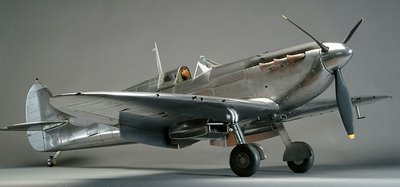 If anyone asked me why I set out to build a Spitfire in one-fifth scale, and detailed to the last rivet and fastener, I would probably be hard-pushed for a practical or even sensible answer. Perhaps the closest I can get is that since a small child I have been awe inspired by R. J. Mitchell’s elliptical winged masterpiece, and that to build a small replica is the closest I will ever aspire to possession.
If anyone asked me why I set out to build a Spitfire in one-fifth scale, and detailed to the last rivet and fastener, I would probably be hard-pushed for a practical or even sensible answer. Perhaps the closest I can get is that since a small child I have been awe inspired by R. J. Mitchell’s elliptical winged masterpiece, and that to build a small replica is the closest I will ever aspire to possession.
The job took me well over eleven years, during which there were times I very nearly came to giving the project up for lost. The sheer amount of work involved, countless hours, proved almost too much, were it not for a serendipitous encounter at my flying club in Cambridge with Dr Michael Fopp, Director General of the Royal Air Force Museum in England .
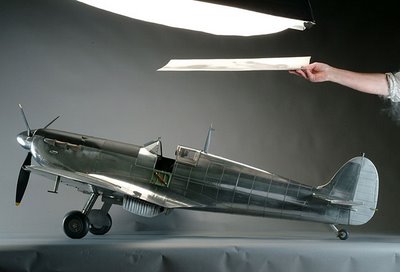 Seeing the near complete fuselage, he urged me to go on and finish the model, promising that he would put it on display. I was flabbergasted, for when I started I had no inkling that my work would end up in a position of honour in one of the world’s premier aviation museums.
Seeing the near complete fuselage, he urged me to go on and finish the model, promising that he would put it on display. I was flabbergasted, for when I started I had no inkling that my work would end up in a position of honour in one of the world’s premier aviation museums.
As I write, the case for the model is being prepared, having been specially commissioned by the museum with a case-maker in Sweden . I have not yet seen it, but from what I hear, it is enormous!
In one respect the story has gone full circle, since it was at Hendon where I started my research in earnest, sourcing Microfilm copies of many original Supermarine drawings, without which such a detailed build would not have been possible.
The model is skinned with litho plate over a balsa core and has been left in bare metal at the suggestion of Michael Fopp, so that the structure is seen to best advantage. The rivets are real and many are pushed into drilled holes in the skin and underlying balsa, but many more are actual mechanical fixings. I have no accurate count, but I suspect that there are at least 19,000!
 All interior detail is built from a combination of Supermarine drawings and workshop manuals, plus countless photographs of my own, many of them taken opportunistically when I was a volunteer at the Duxford Aviation Society based at Duxford Airfield, home of the incomparable Imperial War Museum collection in Cambridgeshire, England. Spitfires, in various marks are, dare I say, a common feature there!
All interior detail is built from a combination of Supermarine drawings and workshop manuals, plus countless photographs of my own, many of them taken opportunistically when I was a volunteer at the Duxford Aviation Society based at Duxford Airfield, home of the incomparable Imperial War Museum collection in Cambridgeshire, England. Spitfires, in various marks are, dare I say, a common feature there!
 The degree of detail is probably obsessive: The needles of the dials in the cockpit actually stand proud of the instrument faces, but you have to look hard to see it! Why the flat canopy? Well, the early Mk.Is had them, and I had no means to blow a bubble hood, so it was convenient. Similarly the covers over the wheels were another early feature and they saved me a challenging task of replicating the wheel castings.
The degree of detail is probably obsessive: The needles of the dials in the cockpit actually stand proud of the instrument faces, but you have to look hard to see it! Why the flat canopy? Well, the early Mk.Is had them, and I had no means to blow a bubble hood, so it was convenient. Similarly the covers over the wheels were another early feature and they saved me a challenging task of replicating the wheel castings.

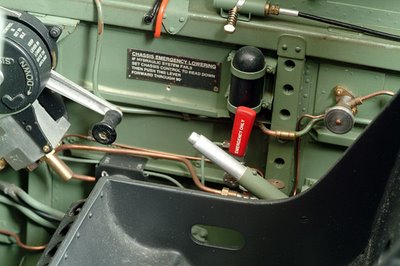 The model has its mistakes, but I’ll leave the experts to spot them, as they most certainly will, plus others I don’t even know about. I don’t pretend the little Spitfire is perfect, but I do hope it has captured something of the spirit and incomparable beauty of this magnificent fighter – perhaps the closest to a union that art and technology have ever come – a killing machine with lines that are almost sublime.
The model has its mistakes, but I’ll leave the experts to spot them, as they most certainly will, plus others I don’t even know about. I don’t pretend the little Spitfire is perfect, but I do hope it has captured something of the spirit and incomparable beauty of this magnificent fighter – perhaps the closest to a union that art and technology have ever come – a killing machine with lines that are almost sublime.
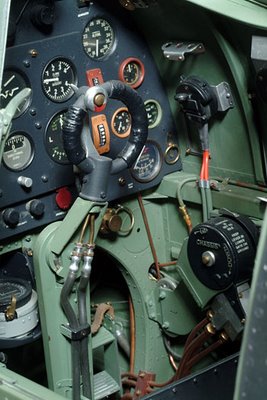





So, with the model now in its magnificent new home, what comes next?
Well, I’m planning a book that will have a lot to say about its genesis and perhaps just a little about me and those dear to me, including a long suffering but understanding and supportive wife. And then there’s the Mustang… Yes, a 1/5th scale P-51D is already taking shape in my workshop. How long will it take? I’ve no idea, but what I am sure of is that at my age (58) I can’t expect to be building many of them!
David Glen
Whaddon, Cambridge
Dec. 06, 2006
------------------------------------------------------------------------
"Mind-numbing"! I can barely fold a proper "paper airplane", and this man builds a Spitfire. Very talented. The magnificent artifact is approximately four feet long and will occupy a place of honour in the Royal Air Force Museum in England.
***EXTRA***
My "thought-challenged" cranial mass started to "whirr", and I wondered if there was a "working" Rolls-Royce Merlin engine that would "mate" with David's airplane. After a little research, "Guess what"? Check out pictures of a 1/5 scale "working" Merlin engine. This engine was built by Barrington Hares in the 1980s, and runs. He has also recently built a Rolls Royce 24 cylinder, sleeve valve, H-configuration "Eagle". Click on the photos of both engines in the following "links" to expand them full-screen, they are unreal and astounding. Such minute detail!
LINK - Barry Hares' 1/5 Scale Rolls-Royce "Merlin"
LINK - Barry Hares' 1/5 Scale Rolls-Royce "Eagle"
Great job, David Glen and Barrington Hares! Thanks for the "tip", Rodger!
"Adios"!
-------------------------------------------------------------------------
 If anyone asked me why I set out to build a Spitfire in one-fifth scale, and detailed to the last rivet and fastener, I would probably be hard-pushed for a practical or even sensible answer. Perhaps the closest I can get is that since a small child I have been awe inspired by R. J. Mitchell’s elliptical winged masterpiece, and that to build a small replica is the closest I will ever aspire to possession.
If anyone asked me why I set out to build a Spitfire in one-fifth scale, and detailed to the last rivet and fastener, I would probably be hard-pushed for a practical or even sensible answer. Perhaps the closest I can get is that since a small child I have been awe inspired by R. J. Mitchell’s elliptical winged masterpiece, and that to build a small replica is the closest I will ever aspire to possession.The job took me well over eleven years, during which there were times I very nearly came to giving the project up for lost. The sheer amount of work involved, countless hours, proved almost too much, were it not for a serendipitous encounter at my flying club in Cambridge with Dr Michael Fopp, Director General of the Royal Air Force Museum in England .
 Seeing the near complete fuselage, he urged me to go on and finish the model, promising that he would put it on display. I was flabbergasted, for when I started I had no inkling that my work would end up in a position of honour in one of the world’s premier aviation museums.
Seeing the near complete fuselage, he urged me to go on and finish the model, promising that he would put it on display. I was flabbergasted, for when I started I had no inkling that my work would end up in a position of honour in one of the world’s premier aviation museums.As I write, the case for the model is being prepared, having been specially commissioned by the museum with a case-maker in Sweden . I have not yet seen it, but from what I hear, it is enormous!
In one respect the story has gone full circle, since it was at Hendon where I started my research in earnest, sourcing Microfilm copies of many original Supermarine drawings, without which such a detailed build would not have been possible.
The model is skinned with litho plate over a balsa core and has been left in bare metal at the suggestion of Michael Fopp, so that the structure is seen to best advantage. The rivets are real and many are pushed into drilled holes in the skin and underlying balsa, but many more are actual mechanical fixings. I have no accurate count, but I suspect that there are at least 19,000!
 All interior detail is built from a combination of Supermarine drawings and workshop manuals, plus countless photographs of my own, many of them taken opportunistically when I was a volunteer at the Duxford Aviation Society based at Duxford Airfield, home of the incomparable Imperial War Museum collection in Cambridgeshire, England. Spitfires, in various marks are, dare I say, a common feature there!
All interior detail is built from a combination of Supermarine drawings and workshop manuals, plus countless photographs of my own, many of them taken opportunistically when I was a volunteer at the Duxford Aviation Society based at Duxford Airfield, home of the incomparable Imperial War Museum collection in Cambridgeshire, England. Spitfires, in various marks are, dare I say, a common feature there! The degree of detail is probably obsessive: The needles of the dials in the cockpit actually stand proud of the instrument faces, but you have to look hard to see it! Why the flat canopy? Well, the early Mk.Is had them, and I had no means to blow a bubble hood, so it was convenient. Similarly the covers over the wheels were another early feature and they saved me a challenging task of replicating the wheel castings.
The degree of detail is probably obsessive: The needles of the dials in the cockpit actually stand proud of the instrument faces, but you have to look hard to see it! Why the flat canopy? Well, the early Mk.Is had them, and I had no means to blow a bubble hood, so it was convenient. Similarly the covers over the wheels were another early feature and they saved me a challenging task of replicating the wheel castings.
 The model has its mistakes, but I’ll leave the experts to spot them, as they most certainly will, plus others I don’t even know about. I don’t pretend the little Spitfire is perfect, but I do hope it has captured something of the spirit and incomparable beauty of this magnificent fighter – perhaps the closest to a union that art and technology have ever come – a killing machine with lines that are almost sublime.
The model has its mistakes, but I’ll leave the experts to spot them, as they most certainly will, plus others I don’t even know about. I don’t pretend the little Spitfire is perfect, but I do hope it has captured something of the spirit and incomparable beauty of this magnificent fighter – perhaps the closest to a union that art and technology have ever come – a killing machine with lines that are almost sublime.





So, with the model now in its magnificent new home, what comes next?
Well, I’m planning a book that will have a lot to say about its genesis and perhaps just a little about me and those dear to me, including a long suffering but understanding and supportive wife. And then there’s the Mustang… Yes, a 1/5th scale P-51D is already taking shape in my workshop. How long will it take? I’ve no idea, but what I am sure of is that at my age (58) I can’t expect to be building many of them!
David Glen
Whaddon, Cambridge
Dec. 06, 2006
------------------------------------------------------------------------
"Mind-numbing"! I can barely fold a proper "paper airplane", and this man builds a Spitfire. Very talented. The magnificent artifact is approximately four feet long and will occupy a place of honour in the Royal Air Force Museum in England.
***EXTRA***
My "thought-challenged" cranial mass started to "whirr", and I wondered if there was a "working" Rolls-Royce Merlin engine that would "mate" with David's airplane. After a little research, "Guess what"? Check out pictures of a 1/5 scale "working" Merlin engine. This engine was built by Barrington Hares in the 1980s, and runs. He has also recently built a Rolls Royce 24 cylinder, sleeve valve, H-configuration "Eagle". Click on the photos of both engines in the following "links" to expand them full-screen, they are unreal and astounding. Such minute detail!
LINK - Barry Hares' 1/5 Scale Rolls-Royce "Merlin"
LINK - Barry Hares' 1/5 Scale Rolls-Royce "Eagle"
Great job, David Glen and Barrington Hares! Thanks for the "tip", Rodger!
"Adios"!
Wednesday, January 24, 2007
Steve's Video Of The Day: "Check" Out the "Coax" on These "Kamovs"!
Quite the design, these "coaxial" helicopters. My brother "Gene, Recessive" (Corey) flew the Kamov Ka-32 overseas for awhile, and he says they can really lift. Typical Russian design, built to be "robust", "practical", and "ready to work". Igor Sikorsky would be proud!
VIDEO - "Check" Out the "Coax" on These "Kamovs"!
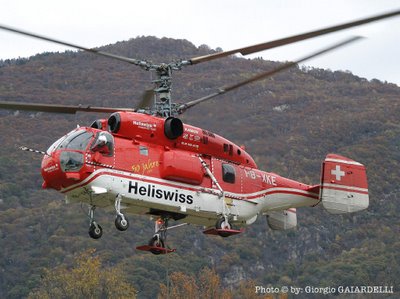
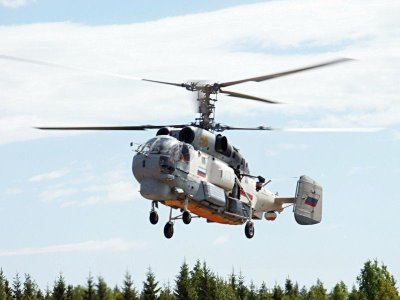 Kamov Ka-32s! These helicopters are "brutes"!
Kamov Ka-32s! These helicopters are "brutes"! 
VIDEO - "Check" Out the "Coax" on These "Kamovs"!

 Kamov Ka-32s! These helicopters are "brutes"!
Kamov Ka-32s! These helicopters are "brutes"! 
Canadian Warplane Heritage Museum "Residents".....
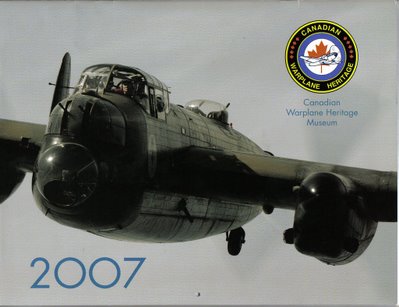
The Canadian Warplane Heritage Museum (CHWM) is a non-profit organization whose purpose is to acquire, preserve, document, maintain, and "share history" of a fleet of aircraft that were operated and flown by the Canadian Military from the beginning of World War II to the present day. The Museum is located at 9280 Airport Road, Mount Hope, at the Hamilton International Airport, Ontario, and is open year-round from 9 AM to 5 PM, except Christmas and New Years' Days.
Every year the CWHM produces a calendar, with her "residents" modeling for the photo shoot, and every year the Canadian Owners and Pilots Association (COPA) sends out the CWHM calendar with "COPA Flight" towards the end of the year. Being a COPA member for many years, I always receive the calendar, and anxiously anticipate it's arrival. So, I would now like to share the photos from it with you, in case you haven't seen them. They are fantastic photos of fantastic specimens.
MISS JANUARY
 North American T-28 "Trojan". The "Trojan" was designed to replace the T-6 "Texan"s as a trainer for the U.S. Navy and Air Force. Over 15 different nations operated the Trojan, and 1,948 were built between 1950 and 1957.
North American T-28 "Trojan". The "Trojan" was designed to replace the T-6 "Texan"s as a trainer for the U.S. Navy and Air Force. Over 15 different nations operated the Trojan, and 1,948 were built between 1950 and 1957.MISS FEBRUARY
 The Fleet Fort Model 60K was the only aircraft designed and built by Canadians in World War II. The rest of the aeroplanes produced in this country were constructed under license. The Fort was also the first all-metal monoplane built by Fleet Aircraft of Canada (Fort Erie); and it was intended as a cheaper version of the Harvard, also an intermediate trainer. The Fort's maiden flight occurred in 1940, and the RCAF took an additional 100 on strength in 1941.
The Fleet Fort Model 60K was the only aircraft designed and built by Canadians in World War II. The rest of the aeroplanes produced in this country were constructed under license. The Fort was also the first all-metal monoplane built by Fleet Aircraft of Canada (Fort Erie); and it was intended as a cheaper version of the Harvard, also an intermediate trainer. The Fort's maiden flight occurred in 1940, and the RCAF took an additional 100 on strength in 1941.Initially, the RCAF did not want to order the Model 60K, and their doubts proved valid. The Fort was relatively easy for pilot trainees to master, thereby making it unsuitable for transition to combat aircraft (e.g., Hawker Hurricane). Also, the RCAF decided that pilots who had soloed in Finches and Tiger Moths could proceed to Harvards without training on Forts. The Forts were then used to train wireless operators until the last Model 60K was retired in 1946.
The CWH Fort was the prototype that was employed by the National Research Council Test and Development Establishment until it was assigned to 2 Wireless School in 1942. The Museum acquired this aircraft in 1979. The following year, Fleet Aerospace, having just rebuilt the Cornell, volunteered to return the Fort to airworthy status. It is the only example of this type, world-wide, to still fly.
MISS MARCH
 Probably the most famous Allied bomber of World War II, the Lancaster had impressive flying characteristics and operational performance. The Lancaster was the RAF's only heavy bomber capable of carrying the 12,000-lb Tallboy and 22,000-lb Grand Slam bombs. The aircraft demonstrated superbly its right to fame with the daring and precise raids on the Ruhr dams in May 1943, and also the sinking of the German battleship Tirpitz in November 1944.
Probably the most famous Allied bomber of World War II, the Lancaster had impressive flying characteristics and operational performance. The Lancaster was the RAF's only heavy bomber capable of carrying the 12,000-lb Tallboy and 22,000-lb Grand Slam bombs. The aircraft demonstrated superbly its right to fame with the daring and precise raids on the Ruhr dams in May 1943, and also the sinking of the German battleship Tirpitz in November 1944.Thousands of Canadian aircrew and other personnel served with the RCAF and RAF's Lancaster squadrons in England; and thousands of Canadians at home worked at Victory Aircraft in Malton (Toronto), Ontario, where they produced over 400 Lancaster Mk X's. In total, more than 7300 Lancasters rolled off the production lines in Britain and Canada. Only two still fly.
The CWH Museum has dedicated its Mynarski Memorial Lancaster to the memory of Pilot Officer Andrew Charles Mynarski, VC, of 419 (Moose) Squadron, 6 (RCAF) Group. Mynarski won 6 Group's only Victoria Cross, the Commonwealth's highest award for gallantry in battle. On the night of 12/13 June 1944, his Lancaster X was shot down by a Luftwafffe night fighter. As the bomber plunged earthwards, Mynarski, his flying clothing afire, tried in vain to free his trapped rear gunner from the jammed rear turret. Miraculously, the gunner lived to relate the story of Mynarski's bravery. Unfortunately, Mynarski died from his severe burns.
MISS APRIL
 The Firefly served as a carrier-borne reconnaissance fighter in both World War II and the Korean War. Fairey Aviation (Britain) Company's original prototype first flew in 1941 and, two years later, the aircraft became operational with the Royal Navy Fleet Air Arm. In total, 1623 Fireflies left the assembly lines. One of the aeroplane's most interesting features is the housing of the pilot and navigator/weapons officer in separate compartments. In addition, the innovative wing flaps, when extended, increased both the wing area and, in turn, their lift. This last feature made the heavy Firefly docile during landings on aircraft carrier decks.
The Firefly served as a carrier-borne reconnaissance fighter in both World War II and the Korean War. Fairey Aviation (Britain) Company's original prototype first flew in 1941 and, two years later, the aircraft became operational with the Royal Navy Fleet Air Arm. In total, 1623 Fireflies left the assembly lines. One of the aeroplane's most interesting features is the housing of the pilot and navigator/weapons officer in separate compartments. In addition, the innovative wing flaps, when extended, increased both the wing area and, in turn, their lift. This last feature made the heavy Firefly docile during landings on aircraft carrier decks.The Royal Canadian Navy employed 65 Fireflies of the Mk AS-5 variety on board its own aircraft carriers between 1946 and 1954. The letters 'AS' stand for anti-submarine, which was the intended primary role of the RCN's Fireflies.
The Museum's Mk 5 was the first aeroplane type acquired for CWH's collection, which explains why the Firefly is pictured on the CWH decals and letterhead. The Camden Air Museum (Australia) provided the Museum with the Firefly, which has been restored in the colours and markings of 825 (RCN) Squadron, which flew Mk 5's from the aircraft carrier HMCS 'Magnificent,' circa 1953.
MISS MAY
 The Boeing Stearman was manufactured as an initial training aeroplane by Boeing Aircraft Company (Witchita Division), which eventually constructed at least 8500 Stearmans, or more than 10,300 if one includes spare parts. No other biplane was ever built in this quantity. Beginning in 1934, the Americans sold the Stearman for export as the 'Kaydet.'
The Boeing Stearman was manufactured as an initial training aeroplane by Boeing Aircraft Company (Witchita Division), which eventually constructed at least 8500 Stearmans, or more than 10,300 if one includes spare parts. No other biplane was ever built in this quantity. Beginning in 1934, the Americans sold the Stearman for export as the 'Kaydet.'The RCAF's 300 Model PT-27's were ordered with special modifications for air training, particularly in Canada's winter weather conditions. The PT-27 required navigation lights, an enclosed, heated cockpit and a blind-flying hood; however, only one Stearman arrived with the enclosed cockpit. After four months of active service with the BCATP, the PT-27s were traded to the US for Fairchild Cornells because of the unsuitability of the open cockpit for winter training.
The CWH aircraft was built in 1942 and is a Model PT-17, which was donated to the collection in 1986. The Stearman is painted in the training colours and markings of a BCATP Elementary Flying Training School (EFTS). Although this aeroplane is a PT-17, the serial number FK107 was chosen to represent the last of the open-cockpit PT-27s supplied to the BCATP.
MISS JUNE
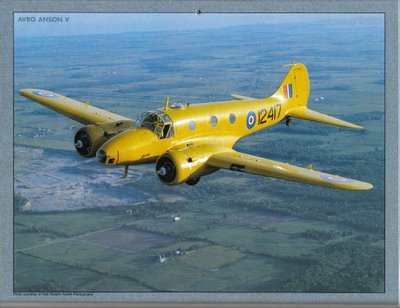 In the 1930s A.V. Roe Company (Britain) built the Avro Anson as a reconnaissance airplane for the RAF. The aircraft began its military service in 1936, becoming the RAF's first monoplane. By 1939 it was already obsolete, and the Lockheed Hudson superceded the Anson in the reconnaissance role. More than 11,000 Ansons were built.
In the 1930s A.V. Roe Company (Britain) built the Avro Anson as a reconnaissance airplane for the RAF. The aircraft began its military service in 1936, becoming the RAF's first monoplane. By 1939 it was already obsolete, and the Lockheed Hudson superceded the Anson in the reconnaissance role. More than 11,000 Ansons were built.In Canada the Anson is best known for its employment in the BCATP as a multi-engined trainer. It quickly became the mainstay of the Air Training Plan that graduated many of the pilots who would fly multi-engined aircraft for the RCAF and RAF. Ansons rendered excellent service to the RCAF until the last one left active service in 1954.
The CWH Anson Mk V-P is a long-range, photographic reconnaissance version. It is an all-wooden aircraft, made in 1944 by MacDonald Brothers Aircraft, Winnipeg, Manitoba. It was donated in 1980, after being used in post-war era for conducting mineral surveys. It now bears the yellow colour of the BCATP's trainers and markings of the wartime RCAF.
MISS JULY
 The Harvard, named after the university, was produced as an export version of the AT-6 Texan advanced trainer. It became the standard advanced trainer for the BCATP in Canada and the RAF in Britain. It was used to train thousands of Commonwealth pilots for combat flying in fighters and fighter-bombers.
The Harvard, named after the university, was produced as an export version of the AT-6 Texan advanced trainer. It became the standard advanced trainer for the BCATP in Canada and the RAF in Britain. It was used to train thousands of Commonwealth pilots for combat flying in fighters and fighter-bombers.The Harvard was well suited to its training role, as it had enough bad habits to teach inexperienced pilots to respect their future, high-performance fighters. The RCAF kept the Harvard on strength as a trainer until 1966. The distinctive snarl of the Harvard has long been a familiar sound in Canadian skies and is produced by its propeller tips approaching sonic speeds when in fine pitch at high revolutions per minute (rpms).
The CWH Harvard was built as a Mark IV variant by Canadian Car and Foundry in November 1951. It saw service at Centralia and Trenton training schools until 1965, when it was sold to the civilian market as surplus.
MISS AUGUST
 The B-25 Mitchell was built by North American Aviation Company in California. Various models were flown in every theatre of war and on missions ranging from bombing, to low-level tank busting and anti-shipping attacks. In the Battle of the Bismarck Sea (Pacific theatre), modified Mitchells with ten forward-firing guns achieved great success against Japanese naval forces. Another historic event was the Doolittle Raid, the Americans' first bombing operation against Japan, which was launched at long-range from the deck of the aircraft carrier USS 'Hornet.'
The B-25 Mitchell was built by North American Aviation Company in California. Various models were flown in every theatre of war and on missions ranging from bombing, to low-level tank busting and anti-shipping attacks. In the Battle of the Bismarck Sea (Pacific theatre), modified Mitchells with ten forward-firing guns achieved great success against Japanese naval forces. Another historic event was the Doolittle Raid, the Americans' first bombing operation against Japan, which was launched at long-range from the deck of the aircraft carrier USS 'Hornet.'The RAF used Mitchells throughout the European and North African campaigns, where many of these aircraft were flown by Canadian crews. After the war, the RCAF operated Mitchells in Canada as navigational trainers until 1963.
The Museum's Mitchell 3 is a B-25 Model J that was manufactured for the post-war. It has been restored to the configuration of an aircraft from 98 Squadron RAF and is also dedicated to the Canadian members of that squadron and all the members of CWH who were awarded the Distinguished Flying Cross.
MISS SEPTEMBER
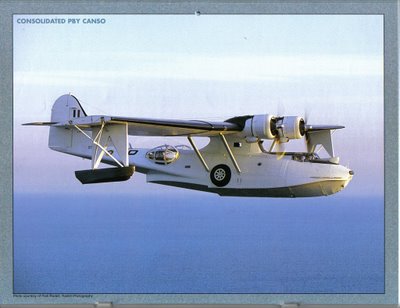 Consolidated's first PBY flying-boat prototype made its maiden flight in 1933. Overall, there were 3431 PBY's, of which 2029 were flying boats (e.g., PBY-5 Catalina) and 1402 were amphibians (e.g., PBY-5A Canso). More Consolidated PBYs were manufactured than any other type of flying boat or amphibian.
Consolidated's first PBY flying-boat prototype made its maiden flight in 1933. Overall, there were 3431 PBY's, of which 2029 were flying boats (e.g., PBY-5 Catalina) and 1402 were amphibians (e.g., PBY-5A Canso). More Consolidated PBYs were manufactured than any other type of flying boat or amphibian.The RCAF chose the PBY-5A in 1939 as its replacement for the Supermarine Stranraer. During World War II, Boeing Aircraft of Canada, Canadian Vickers and Canadair Ltd. made almost 800 PBY's in this country. The RCAF called its version the 'Canso A' - A for amphibious.
Canadian Vickers manufactured CWH's PBY-5A in 1944. It served with the RCAF until 1961 when it was sold as surplus. The Canso is restored in the colours and markings of 162 (Bomber Reconnaissance) Squadron and dedicated to the memory of Flight Lieutenant David Hornell, VC, who was awarded a posthumous Victoria Cross. On 24 June 1944 he and his crew bombed and sank U-1225. Sadly, the Germans shot down the Canso A, and Hornell and his crew spent more than twenty hours afloat on the ocean before being rescued. Hornell died shortly afterward. Acquisition in 1995 of the CWH Canso was made possible by generous donations from Canadian Resident Abroad Inc. and the Beamish Family.
MISS OCTOBER
 In 1937 Beech Aircraft of Wichita, Kansas, produced the Model 18 as a civil transport. The military needs of the Allied Air Forces and the Model 18's continuing popularity stretched the production period over 32 years. During this time, more than 9100 airplanes in 32 variants were built. A key reason for this aircraft's excellent reputation was its versatility. The Model 18 was also known as the 'Exploder,' 'Bug Smasher' and 'Wichita Wobbler.'
In 1937 Beech Aircraft of Wichita, Kansas, produced the Model 18 as a civil transport. The military needs of the Allied Air Forces and the Model 18's continuing popularity stretched the production period over 32 years. During this time, more than 9100 airplanes in 32 variants were built. A key reason for this aircraft's excellent reputation was its versatility. The Model 18 was also known as the 'Exploder,' 'Bug Smasher' and 'Wichita Wobbler.'The Canadians and British called the Beech 18 the C-45 Expeditor. It had many roles such as bombing and weapons training, search and rescue, light transport, photographic reconnaissance and communications. The RCAF received its first Expeditors in 1939 and flew them until the Services were unified in 1968. Retirement from the Canadian Forces came in 1970.
CWH obtained this airplane from a private donor in 1982 after it had flown for many years on commercial and private ventures around the world. Manufactured as a Model D18-C in 1942, this Expeditor was converted to a Model E18-S in 1946, when Pratt & Whitney engines replaced the original Continentals. The paint scheme and markings are of a photographic section of the RCAF circa 1944, which was based at Winnipeg and attached to 403 Squadron.
MISS NOVEMBER
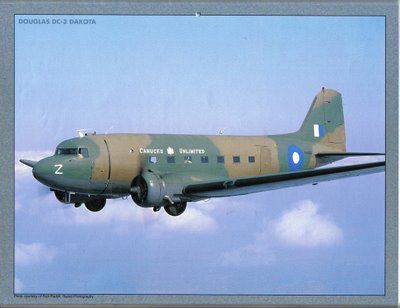 Douglas Aircraft Company built the first DC-3 civil transport aeroplane in 1935. Under its military designation of C-47, the Dakota became the most versatile and widely-used transport aircraft of this century. Its most crucial roles in World War II included cargo and personnel delivery, glider towing and paratroop drops. Douglas built more than 10,000 "Gooney Birds," as the Dakotas are affectionately known. Even the Soviets manufactured more than 2,000 and the Japanese 500 under license. As late as 1990 there were 3,500 Dakotas still flying world wide.
Douglas Aircraft Company built the first DC-3 civil transport aeroplane in 1935. Under its military designation of C-47, the Dakota became the most versatile and widely-used transport aircraft of this century. Its most crucial roles in World War II included cargo and personnel delivery, glider towing and paratroop drops. Douglas built more than 10,000 "Gooney Birds," as the Dakotas are affectionately known. Even the Soviets manufactured more than 2,000 and the Japanese 500 under license. As late as 1990 there were 3,500 Dakotas still flying world wide.In World War II the RCAF had three Dakota squadrons. In 1944, 437 was created in England and served in Northwest Europe; in that same year, 435 and 436 Squadrons were formed in India for service with the British XIV Army in Burma. Between 1943 and 1989, almost one-half of a century, the RCAF and Canadian Forces (CF) Air Command employed 169 Dakotas.
CWH's Dakota proudly wears the colours of 436 Squadron, whose slogan was "Canucks Unlimited." This aeroplane (C-GDAK) was built in June 1939 and, in 1990, was the C-47 with the second highest total of airtime of all operational Dakotas logging over 82,000 hours of air time and 12 million miles. The Museum's Gooney Bird is still being used to deploy parachutists -- but only at air shows. The Museum obtained its Dakota in 1981.
MISS DECEMBER
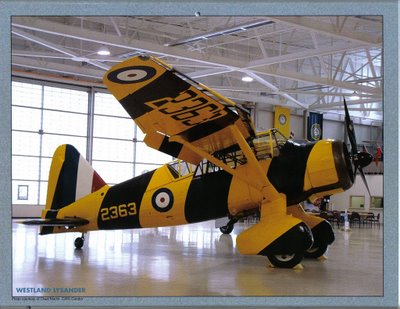 This aircraft (RCAF NO. 2361) was manufactured in 1942 by National Steel Car Company at Malton (Toronto) under license from Westland Aircraft Corporation, England. World-wide, 1660 models were built, 225 in Canada. The STOL (short take off and landing) design uses an elaborate system of leading-edge Handley Page slats and large flaps enabled the aircraft to use unprepared landing strips in battlefield conditions. Under certain conditions as little as 165 yards was all the take-off distance required.
This aircraft (RCAF NO. 2361) was manufactured in 1942 by National Steel Car Company at Malton (Toronto) under license from Westland Aircraft Corporation, England. World-wide, 1660 models were built, 225 in Canada. The STOL (short take off and landing) design uses an elaborate system of leading-edge Handley Page slats and large flaps enabled the aircraft to use unprepared landing strips in battlefield conditions. Under certain conditions as little as 165 yards was all the take-off distance required.In Canada, Lysander aircraft were chiefly used for target towing at training schools, limited navigational training, communications duty, search and rescue operations. During WWII it was most noted for its use to transport operatives into occupied Europe, often returning with escapees including Allied aircrew. The "Lizzie" as named by aircrew, also boasted a Browning 0.303 machine gun housed in each wheel spat. Twelve small bombs could also be carried under sub-wings fitted to the wheel spats.
This aircraft was discovered in Western Canada. The restoration project was started by the Friends of CWH in Niagara Falls, NY in 1983. In 1997, the aircraft was returned to CWH where volunteers continue to restore the aircraft to flying condition. The camouflage paint scheme represents an aircraft of No. 400 Squadron "City of Toronto".
(except for the T-28 "Trojan", all aircraft descriptions are from the CWHM website.)
----------------------------------------------------------
As you can see, a "fine bevy" of "pin-up girls". The CWHM is a fantastic place to visit "online", and I am sure the experience increases "exponentially" once one visits in person. Thanks for all their dedication and hard work applied towards remembering, and keeping Canadian history alive.
***TOUR THE - Canadian Warplane Heritage Museum
WEBSITE - Canadian Warplane Heritage Museum
WEBSITE - Canadian Owners and Pilots Association
READ THE - Andrew Mynarski Story (fine Manitoba boy!)


Tuesday, January 23, 2007
Embry-Riddle Aeronautical University "Carnage"!
I recently made a "Post" entitled "F2 Tornado", at "Embry-Riddle"!. Clive had sent me some info and pics of the devastation that happened at Embry-Riddle Christmas Day, 2006. Well, Greg, from WoodToyFun.com, left a comment on my Aviation.ca "Blog". He took a trip to the "salvage yard" to check out some of the "final results" of the "tornado". He took some pics of what, at one point in "history", could be described as airplanes.
GREG'S PHOTOS - Embry-Riddle Aeronautical University "Carnage"!
I tell you, that was "one helluva' wind"! Thanks for the "tip", Greg, great (sad) photos!
WEBSITE - WoodToyFun.com
WEBSITE - Embry-Riddle Aeronautical University
GREG'S PHOTOS - Embry-Riddle Aeronautical University "Carnage"!
I tell you, that was "one helluva' wind"! Thanks for the "tip", Greg, great (sad) photos!
WEBSITE - WoodToyFun.com
WEBSITE - Embry-Riddle Aeronautical University
Steve's Video Of The Day: Let's "Hit The Silk"!
"Hey", what do you get when you mix a few airplanes, great weather, and 81 people wearing "bed sheets"? Why, a "World Record", of course!
VIDEO -
Let's "Hit The Silk"!Monday, January 22, 2007
Steve's "Otter Of The Week"!......by Karl E. Hayes
I have been helping run a hockey tournament with Conn Smythe Trophy winner and Philadelphia Flyers Alumni Reggie Leach since Thursday, and it has been "early mornings and late nights". Anyways, again we continue with our series profiling a different Otter every week, with the information coming from Karl Hayes' "masterful" CD entitled:
De Havilland Canada
DHC-3 OTTER
A HISTORY
I have profiled Otters 1, 2, and 456. If people are curious as to the "whereabouts" of the "first" Otter made, being the "oldest", they are certainly comparatively curious as to the "fate" of the "last" Otter made. Well, let's "hunt down" the youngest Otter, after some "acknowledgements" from Karl.
---------------------------------------------------------------------------
Acknowledgements
This work would not have been possible but for the high level of co-operation received from many military units, government departments, operators and enthusiasts throughout the world and I would personally like to express my appreciation to all who have helped.
MILITARY
Argentina
Air Commodore Juan J.Ahets Etcheberry, Air & Military Attache, Argentine Embassy, London
Australia
Robert Kendall Piper, Chief Executive Officer, Historical Studies and D.H.Taylor, Chief Administrative Officer, both of the Department of Defence; L.Bernadas of the Department of Transport and Flight Lieutenant A.Woodward, RAAF.
Bangladesh
Group Captain A.B.M.Zakaria and Wing Commander R.K.Talukdar, Air HQ, Dacca
Canada
Colonel J.G.Boulet, Director of Information Services, Ottawa and Lieutenant-Colonel D.D.Landreville, Commanding Officer, 400 Squadron, Downsview; W.A.B. Douglas, Directorate of History, Department of National Defence, Ottawa; the staff of the Military Archives, Ottawa and the following persons who gave information on the Canadian military aircraft: Michael Chow, Roy Clark, Clive Cozens, Robert Davis, Don Eddie, George Georgas, Serge Holoduke (recommended website: www.holoduke.com), K.Kusek, Fred Kuzyk , John McClenaghan, Frank Morrow, Ron Richardson and Jerry Vernon.
Chile
Colonels S.J.Contardo and R.I.Vega of the Chilean Air Force Mission, London
Ghana
Air Vice Marshal John Odaate Barnor
India
Squadron Leader N.Prasad of Air HQ, Delhi and Wing Commander S.Krishnaswamy, Air Adviser, High Commission of India, London; Rupak Chattopadhyay.
Indonesia
Air Vice Marshal Roesman, Jakarta
New Zealand
The High Commission, London
Norway
Engineer Per-Oivind Skarphol, Material Command, Kjeller Air Base; Steinar Saevdal. A big word of thanks is due to Steinar for sharing all his information on the Norwegian Otters.
Royal Air Force
Mr F.Flower, Senior Museum Assistant, RAF Museum and D.W.Goode, Chief Librarian, Royal Aircraft Establishment, Farnborough.
United States Army
The staff of the Army Aviation Museum, Fort Rucker, Alabama; Roger C.Lance, Directorate of Sales, Defence Logistics Agency; G.K.Alford, Chief, Troop Support & Aviation Material Readiness Command, St.Louis; General Services Administration, Washington; Golden Knights Parachute Team; US Army Safety Centre, Fort Rucker (Vickie Hendrix); US Army Aviation Centre, Aviation Branch Historian (James W.Williams); US Army Logistics Support Activity, Redstone Arsenal, Alabama; Centre of Military History, Washington (Edward N Bedessem); Military History Institute, Carlisle Barracks, Pennsylvania.
United States Air Force
James N. Eastman Jr, Chief, Research Division, Maxwell AFB, Alabama; Ned S.Robinson, Chief, Aircraft Disposition Office, Davis-Monthan AFB, Arizona; David Menard.
United States Navy
Lt.Commander C.A. Wheal, Royal Navy and Jerry Gallagher, both of the Naval Test Pilots School, Patuxent River NAS; staff of the Naval Aviation Museum, Pensacola, Florida; William J.Armstrong, Historian, Naval Air Systems Command; Mark R. Sharpe, Assistant Public Affairs Officer, El Centro NAF, California; Richard M.Walker and Bob Chenoweth both of the Office of the Chief of Naval Operations, Naval Aviation History, Washington; Commander Jim Waldron; Joe Hawkins, Aviation History Branch, Naval Historical centre, Washington.
Otter 466
Otter 466, the last DHC-3 off the production line, was delivered to Laurentian Air Services Ltd, Ottawa on 16th June 1967, registered CF-VQD. It served with this operator for ten years, mostly flying in Quebec, until sold to Sabourin Lake Airways Ltd (Sabair) of Cochenour, Ontario in June 1977, re-registered C-FVQD. This was a 'First Nations' airline, owned by seven native communities in northwestern Ontario, which also flew Otter C-GPHD (113). Otter VQD was to fly for Sabair for nearly twenty years. The Otters were used to service remote northern settlements and for tourists, fishermen, hunters during the summer months.
An incident is recorded at Lingman Lake, Ontario on 19th December 1987 when after the engine was shut down, the Otter sank through the ice. It was repaired. VQD was involved in another incident at Sandy Lake, Ontario, on 5th December 1991. The Otter had started its engine on the ramp. A truck stopped in front of the Otter to drop off passengers for another aircraft. The pilot of the Otter was unaware of the truck and taxied forward. The propeller contacted the roof of the truck's camper top, fortunately without injury or damage to the Otter which, after inspection, was returned to service. The driver of the truck had not been trained in ramp procedures.
In July 1996 the Otter was sold to Black Sheep Aviation & Cattle Company Ltd of Whitehorse, Yukon Territory. It was involved in an incident on 4th September '96 landing on a remote mountain strip fifty miles north of Mayo in the Yukon. The Otter was carrying a load of mining supplies. A light tail wind existed and during the landing roll a crest in the runway caused the aircraft to become airborne for a short distance. The pilot was unable to stop before running off the end of the strip into the bushes. The main landing gear, propeller and empennage sustained damage. The Otter was repaired and in April 1998 sold to Eagle Aviation Ltd of Silver Falls, Manitoba and went on lease to Blue Water Aviation Services Ltd, also of Silver Falls, Manitoba. VQD went on lease from Eagle Aviation to Sowind Air of Little Grand Rapids, Manitoba from April 1999 for that summer, registered again to Blue Water Aviation Services in May 2000, another lease from Eagle Aviation. On 5th April 2001 it was registered to Wamair Service & Outfitting Inc of Matheson Island, Manitoba and on 18th June 2002 it was registered to 3097448 Manitoba Ltd (Adventure Air) of Silver Falls, all these being leases from its owner, Eagle Aviation.
Eagle Aviation arranged for VQD to be converted to a turbine Otter with a Walter engine, the work being done by AOG Air Support at their Kelowna, BC facility. It thus became the second Otter to be converted with the Walter engine, after Eagle Aviation's C-FIOF (24), which was the first. VQD starred at the Otter's 50th anniversary celebrations held at Victoria, BC in October 2002, impressing all with its agility, even on amphibious floats. Having spent that winter parked at Vernon, BC, it went on lease from Eagle Aviation to Inland Air Charters Ltd, based at Seal Cove, Prince Rupert, BC in May 2003, joining Inland Air's piston Otter C-FRHW (445), used on the company's scheduled and charter services out of Prince Rupert. It was still leased to Inland Air and operating out of Seal Cove, Prince Rupert during 2004.
*Latest Update!*
Otter 466
C-FVQD.
The Otter was at the AOG facility at Kelowna, BC in February 2005 with its engine removed for inspection purposes. It is the first Walter engined Otter to have been operated in a salt water environment on lease to Inland Air Charters at Prince Rupert on the Pacific Coast, and inspection was necessary to see how it had fared. Its lease to Inland Air had ended, and by mid April VQD had departed from Kelowna and returned to its base at Silver Falls, Manitoba. For summer 2005 it was leased by its owners, Adventure Air, to Northway Aviation based at Pine Dock, Manitoba. An incident was recorded on 10 June 2005 at St. Andrews Airstrip, Winnipeg. The Otter, on amphibious floats, had just undergone maintenance to replace the brake pads, and was on a taxi run on runway 18 to seat the new pads. The calliper seals on the left brake leaked brake fluid onto brake assembly and at the end of the taxi run a small fire occurred on the left brake. The fire self extinguished. The left tire and brake seals were replaced and the Otter returned to service. VQD continued flying for Northway Aviation for the remainder of the summer 2005 season, before being parked for the winter of 2005/06 at its Silver Falls base. It was again leased by Adventure Air to Northway Aviation for the summer of 2006, serving the native communities of Little Grand Rapids and Pauingassi.
- by Karl E. Hayes
--------------------------------------------------------------------------
Great to see the "old girl" is still "flogging the bush". I have "fondled" this aircraft before, flying her in the summer of 2000. Anyhow, check out some of my pics of VQD from the last 7 years.
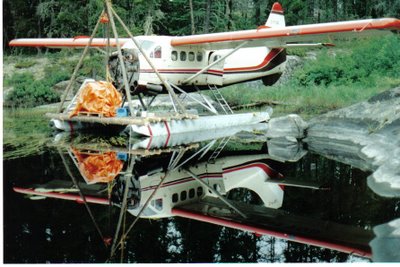 VQD sits "tail in" at Otig Lake, after "blowing" her Pratt and Whitney 1340 engine, being piloted by Ed Gaffray. Ed's Dad Art, and his Uncle Don, came to the rescue, and changed the engine in the bush, and VQD was flown out by Ed.
VQD sits "tail in" at Otig Lake, after "blowing" her Pratt and Whitney 1340 engine, being piloted by Ed Gaffray. Ed's Dad Art, and his Uncle Don, came to the rescue, and changed the engine in the bush, and VQD was flown out by Ed.
 Back on the dock at Silver Falls after the engine change.
Back on the dock at Silver Falls after the engine change.
 Two of my kids, Kaitlan and Shane, check VQD out. "Yup, Dad, she is ready to go!"
Two of my kids, Kaitlan and Shane, check VQD out. "Yup, Dad, she is ready to go!"
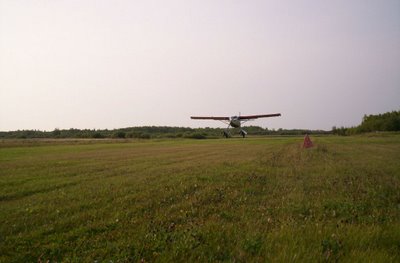 VQD is now a Walter turbine-engined aircraft, landing on the turf strip at Silver Falls.
VQD is now a Walter turbine-engined aircraft, landing on the turf strip at Silver Falls.
 Taxiing past.
Taxiing past.
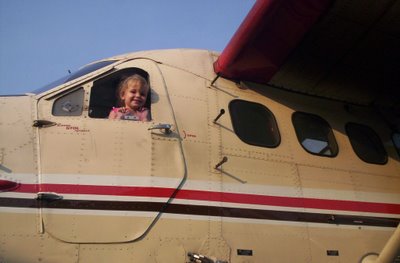 Check out the pilot!
Check out the pilot!
 Just kidding! Doug "McLeod" Burton is the pilot!
Just kidding! Doug "McLeod" Burton is the pilot!
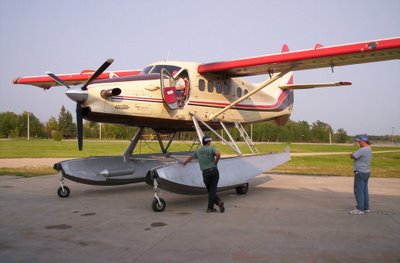 "Securing" for the night.
"Securing" for the night.
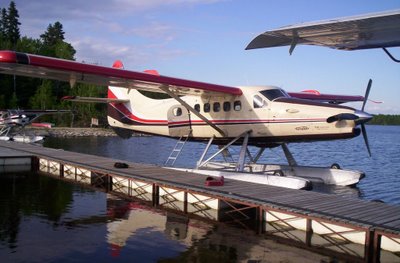 "On the dock", at Pine Dock, summer 2006.
"On the dock", at Pine Dock, summer 2006.
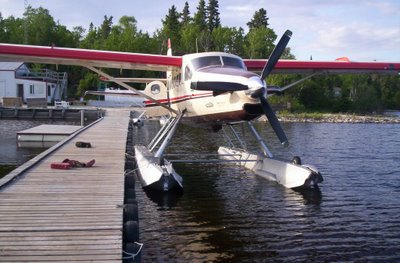
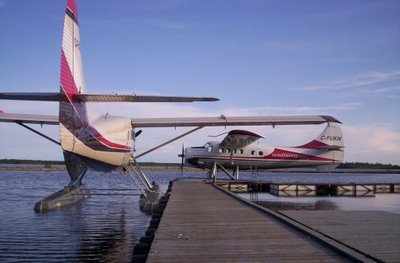 Working with sister-ship UKN at Sasaginnigak Lake.
Working with sister-ship UKN at Sasaginnigak Lake.
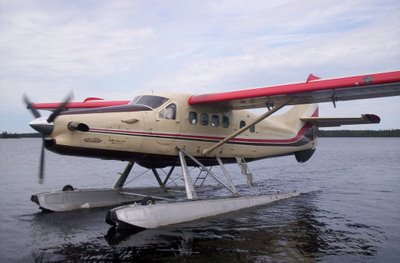 Making a "run", and returning to "Sas".
Making a "run", and returning to "Sas".
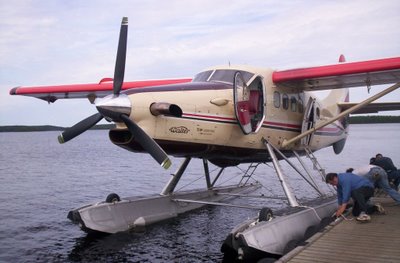 Tieing the "old girl" to the dock.
Tieing the "old girl" to the dock.
 Parked for the night.
Parked for the night. 
So, you see, VQD is still in great shape, and quite active for a "lady" who will be 41 years old this summer! Great content, as usual, Karl! Top-notch!
CONTACT and CD INFO - De Havilland DHC-3 OTTER - A HISTORY by Karl E. Hayes
(P.S. - I know of a 3 month job flying a turbine Otter on skis hauling fuel. Anyone "experienced" interested? Contact me or leave a comment with your contact info.)
Till next time, "Adios"!
De Havilland Canada
DHC-3 OTTER
A HISTORY
I have profiled Otters 1, 2, and 456. If people are curious as to the "whereabouts" of the "first" Otter made, being the "oldest", they are certainly comparatively curious as to the "fate" of the "last" Otter made. Well, let's "hunt down" the youngest Otter, after some "acknowledgements" from Karl.
---------------------------------------------------------------------------
Acknowledgements
This work would not have been possible but for the high level of co-operation received from many military units, government departments, operators and enthusiasts throughout the world and I would personally like to express my appreciation to all who have helped.
MILITARY
Argentina
Air Commodore Juan J.Ahets Etcheberry, Air & Military Attache, Argentine Embassy, London
Australia
Robert Kendall Piper, Chief Executive Officer, Historical Studies and D.H.Taylor, Chief Administrative Officer, both of the Department of Defence; L.Bernadas of the Department of Transport and Flight Lieutenant A.Woodward, RAAF.
Bangladesh
Group Captain A.B.M.Zakaria and Wing Commander R.K.Talukdar, Air HQ, Dacca
Canada
Colonel J.G.Boulet, Director of Information Services, Ottawa and Lieutenant-Colonel D.D.Landreville, Commanding Officer, 400 Squadron, Downsview; W.A.B. Douglas, Directorate of History, Department of National Defence, Ottawa; the staff of the Military Archives, Ottawa and the following persons who gave information on the Canadian military aircraft: Michael Chow, Roy Clark, Clive Cozens, Robert Davis, Don Eddie, George Georgas, Serge Holoduke (recommended website: www.holoduke.com), K.Kusek, Fred Kuzyk , John McClenaghan, Frank Morrow, Ron Richardson and Jerry Vernon.
Chile
Colonels S.J.Contardo and R.I.Vega of the Chilean Air Force Mission, London
Ghana
Air Vice Marshal John Odaate Barnor
India
Squadron Leader N.Prasad of Air HQ, Delhi and Wing Commander S.Krishnaswamy, Air Adviser, High Commission of India, London; Rupak Chattopadhyay.
Indonesia
Air Vice Marshal Roesman, Jakarta
New Zealand
The High Commission, London
Norway
Engineer Per-Oivind Skarphol, Material Command, Kjeller Air Base; Steinar Saevdal. A big word of thanks is due to Steinar for sharing all his information on the Norwegian Otters.
Royal Air Force
Mr F.Flower, Senior Museum Assistant, RAF Museum and D.W.Goode, Chief Librarian, Royal Aircraft Establishment, Farnborough.
United States Army
The staff of the Army Aviation Museum, Fort Rucker, Alabama; Roger C.Lance, Directorate of Sales, Defence Logistics Agency; G.K.Alford, Chief, Troop Support & Aviation Material Readiness Command, St.Louis; General Services Administration, Washington; Golden Knights Parachute Team; US Army Safety Centre, Fort Rucker (Vickie Hendrix); US Army Aviation Centre, Aviation Branch Historian (James W.Williams); US Army Logistics Support Activity, Redstone Arsenal, Alabama; Centre of Military History, Washington (Edward N Bedessem); Military History Institute, Carlisle Barracks, Pennsylvania.
United States Air Force
James N. Eastman Jr, Chief, Research Division, Maxwell AFB, Alabama; Ned S.Robinson, Chief, Aircraft Disposition Office, Davis-Monthan AFB, Arizona; David Menard.
United States Navy
Lt.Commander C.A. Wheal, Royal Navy and Jerry Gallagher, both of the Naval Test Pilots School, Patuxent River NAS; staff of the Naval Aviation Museum, Pensacola, Florida; William J.Armstrong, Historian, Naval Air Systems Command; Mark R. Sharpe, Assistant Public Affairs Officer, El Centro NAF, California; Richard M.Walker and Bob Chenoweth both of the Office of the Chief of Naval Operations, Naval Aviation History, Washington; Commander Jim Waldron; Joe Hawkins, Aviation History Branch, Naval Historical centre, Washington.
Otter 466
Otter 466, the last DHC-3 off the production line, was delivered to Laurentian Air Services Ltd, Ottawa on 16th June 1967, registered CF-VQD. It served with this operator for ten years, mostly flying in Quebec, until sold to Sabourin Lake Airways Ltd (Sabair) of Cochenour, Ontario in June 1977, re-registered C-FVQD. This was a 'First Nations' airline, owned by seven native communities in northwestern Ontario, which also flew Otter C-GPHD (113). Otter VQD was to fly for Sabair for nearly twenty years. The Otters were used to service remote northern settlements and for tourists, fishermen, hunters during the summer months.
An incident is recorded at Lingman Lake, Ontario on 19th December 1987 when after the engine was shut down, the Otter sank through the ice. It was repaired. VQD was involved in another incident at Sandy Lake, Ontario, on 5th December 1991. The Otter had started its engine on the ramp. A truck stopped in front of the Otter to drop off passengers for another aircraft. The pilot of the Otter was unaware of the truck and taxied forward. The propeller contacted the roof of the truck's camper top, fortunately without injury or damage to the Otter which, after inspection, was returned to service. The driver of the truck had not been trained in ramp procedures.
In July 1996 the Otter was sold to Black Sheep Aviation & Cattle Company Ltd of Whitehorse, Yukon Territory. It was involved in an incident on 4th September '96 landing on a remote mountain strip fifty miles north of Mayo in the Yukon. The Otter was carrying a load of mining supplies. A light tail wind existed and during the landing roll a crest in the runway caused the aircraft to become airborne for a short distance. The pilot was unable to stop before running off the end of the strip into the bushes. The main landing gear, propeller and empennage sustained damage. The Otter was repaired and in April 1998 sold to Eagle Aviation Ltd of Silver Falls, Manitoba and went on lease to Blue Water Aviation Services Ltd, also of Silver Falls, Manitoba. VQD went on lease from Eagle Aviation to Sowind Air of Little Grand Rapids, Manitoba from April 1999 for that summer, registered again to Blue Water Aviation Services in May 2000, another lease from Eagle Aviation. On 5th April 2001 it was registered to Wamair Service & Outfitting Inc of Matheson Island, Manitoba and on 18th June 2002 it was registered to 3097448 Manitoba Ltd (Adventure Air) of Silver Falls, all these being leases from its owner, Eagle Aviation.
Eagle Aviation arranged for VQD to be converted to a turbine Otter with a Walter engine, the work being done by AOG Air Support at their Kelowna, BC facility. It thus became the second Otter to be converted with the Walter engine, after Eagle Aviation's C-FIOF (24), which was the first. VQD starred at the Otter's 50th anniversary celebrations held at Victoria, BC in October 2002, impressing all with its agility, even on amphibious floats. Having spent that winter parked at Vernon, BC, it went on lease from Eagle Aviation to Inland Air Charters Ltd, based at Seal Cove, Prince Rupert, BC in May 2003, joining Inland Air's piston Otter C-FRHW (445), used on the company's scheduled and charter services out of Prince Rupert. It was still leased to Inland Air and operating out of Seal Cove, Prince Rupert during 2004.
*Latest Update!*
Otter 466
C-FVQD.
The Otter was at the AOG facility at Kelowna, BC in February 2005 with its engine removed for inspection purposes. It is the first Walter engined Otter to have been operated in a salt water environment on lease to Inland Air Charters at Prince Rupert on the Pacific Coast, and inspection was necessary to see how it had fared. Its lease to Inland Air had ended, and by mid April VQD had departed from Kelowna and returned to its base at Silver Falls, Manitoba. For summer 2005 it was leased by its owners, Adventure Air, to Northway Aviation based at Pine Dock, Manitoba. An incident was recorded on 10 June 2005 at St. Andrews Airstrip, Winnipeg. The Otter, on amphibious floats, had just undergone maintenance to replace the brake pads, and was on a taxi run on runway 18 to seat the new pads. The calliper seals on the left brake leaked brake fluid onto brake assembly and at the end of the taxi run a small fire occurred on the left brake. The fire self extinguished. The left tire and brake seals were replaced and the Otter returned to service. VQD continued flying for Northway Aviation for the remainder of the summer 2005 season, before being parked for the winter of 2005/06 at its Silver Falls base. It was again leased by Adventure Air to Northway Aviation for the summer of 2006, serving the native communities of Little Grand Rapids and Pauingassi.
- by Karl E. Hayes
--------------------------------------------------------------------------
Great to see the "old girl" is still "flogging the bush". I have "fondled" this aircraft before, flying her in the summer of 2000. Anyhow, check out some of my pics of VQD from the last 7 years.
 VQD sits "tail in" at Otig Lake, after "blowing" her Pratt and Whitney 1340 engine, being piloted by Ed Gaffray. Ed's Dad Art, and his Uncle Don, came to the rescue, and changed the engine in the bush, and VQD was flown out by Ed.
VQD sits "tail in" at Otig Lake, after "blowing" her Pratt and Whitney 1340 engine, being piloted by Ed Gaffray. Ed's Dad Art, and his Uncle Don, came to the rescue, and changed the engine in the bush, and VQD was flown out by Ed. Back on the dock at Silver Falls after the engine change.
Back on the dock at Silver Falls after the engine change. Two of my kids, Kaitlan and Shane, check VQD out. "Yup, Dad, she is ready to go!"
Two of my kids, Kaitlan and Shane, check VQD out. "Yup, Dad, she is ready to go!" VQD is now a Walter turbine-engined aircraft, landing on the turf strip at Silver Falls.
VQD is now a Walter turbine-engined aircraft, landing on the turf strip at Silver Falls. Taxiing past.
Taxiing past. Check out the pilot!
Check out the pilot! Just kidding! Doug "McLeod" Burton is the pilot!
Just kidding! Doug "McLeod" Burton is the pilot! "Securing" for the night.
"Securing" for the night. "On the dock", at Pine Dock, summer 2006.
"On the dock", at Pine Dock, summer 2006.
 Working with sister-ship UKN at Sasaginnigak Lake.
Working with sister-ship UKN at Sasaginnigak Lake. Making a "run", and returning to "Sas".
Making a "run", and returning to "Sas". Tieing the "old girl" to the dock.
Tieing the "old girl" to the dock. Parked for the night.
Parked for the night. 
So, you see, VQD is still in great shape, and quite active for a "lady" who will be 41 years old this summer! Great content, as usual, Karl! Top-notch!
CONTACT and CD INFO - De Havilland DHC-3 OTTER - A HISTORY by Karl E. Hayes
(P.S. - I know of a 3 month job flying a turbine Otter on skis hauling fuel. Anyone "experienced" interested? Contact me or leave a comment with your contact info.)
Till next time, "Adios"!

















